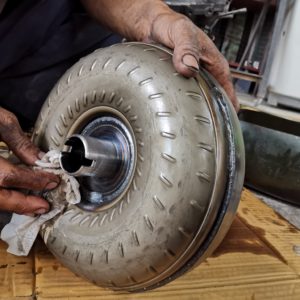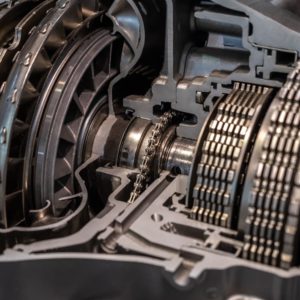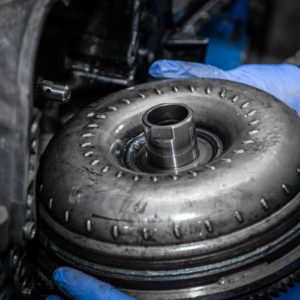A faulty torque converter causes multiple issues that are dangerous to drive with. As such, it’s imperative to replace it immediately.
If you’re unfamiliar with the task, don’t fret. Here is what you can expect when having the torque converter replaced.
What Does Torque Converter Replacement Entail?
Replacing the torque converter involves several steps:
- Step 1: The old torque converter and other components are removed.
- Step 2: The new torque converter’s seal is inspected. Then, the converter is flushed with automatic transmission fluid (ATF).
- Step 3: The pump gear, stator splines, and turbine splines are checked if they’re engaging.
- Step 4: The vehicle is tested to get the adaptive settings close to what they should be and prevent damage to the unit.
Flushing the torque converter means cleaning it with ATF to keep your vehicle working as intended. Failure to do so may accelerate the deterioration of the converter.
What Is a Torque Converter?

The torque converter is a device between the engine and the transmission that has different functions:
- Transmitting and multiplying engine torque
- Acting as a clutch between the engine and the transmission
- Allowing slippage to enable the transmission to engage in gear when the vehicle stops
How Much Does It Cost to Replace a Torque Converter?
Replacing the torque converter costs between $600 and $1,000, depending on the auto repair shop’s labor fee and the new converter’s price. A new part ranges from $150 to $500, depending on the year, make, and model of the car.
How Long Does It Take To Replace a Torque Converter?
It typically takes four to five hours to replace the torque converter. There are also cases when replacement reaches 20 hours, depending on how long it takes to remove the transmission.
It typically takes four to five hours to replace the torque converter.
–Anthony Harlin, ASE Certified Master Automobile Technician
Can I Drive With a Bad Torque Converter?
It’s dangerous to drive with a bad torque converter because it causes issues with acceleration, transmission, and gear shifting, among other things. As such, experts recommend repairing or replacing immediately to limit further damage and prevent potential accidents.
When Should I Replace a Torque Converter?
You should replace or repair the torque converter if you see symptoms that it’s faulty or failing. Have your vehicle diagnosed when you feel gear slipping, shuddering, or rattling noises to confirm whether a bad converter is causing the issue or a different malfunctioning component.
Note that torque converters aren’t repairable, so any damage means you’ll have to replace them.
Can I Replace the Torque Converter Myself?
You can replace the torque converter yourself if you have the proper know-how. The price of having it replaced by professionals is steep because of how tedious the process is, so you can save money if you do it yourself.
But because the converter plays an important part in vehicle functionality, it’s best to leave its replacement to the experts if you’re unsure of the process.

Symptoms of a Bad Torque Converter
A bad torque converter has different symptoms you need to look out for. Most of them involve issues with transmission and gears.
Do note that these symptoms can stem from different issues. It’s difficult to diagnose the torque converter yourself, so it’s best to consult with a mechanic first.
Slipping Transmissions
Excessive or limited fluid usually makes the torque converter faulty. Both cases cause the transmission to slip, making it difficult to shift or stay in gear.
Decreased Speed
Inconsistent torque converter output can decrease speed due to the varying fluid pressure.
Shuddering
You might feel your vehicle shudder when driving with a bad transmission converter. Typically, the vibration starts at 30 to 40 mph. It’s not consistent and continuous, as it tends to come and go.
Car Noise
Due to the different mechanisms the torque converter has, and the various components it’s attached to, a faulty one causes a loud whirring noise when driving.
Overheating Transmission
The transmission has a temperature gauge that warns you if it’s overheating. And because lack of fluid usually causes a faulty torque converter, overheating is another of its common symptoms.
Transmission Fluid Leak
Torque converter damage may also mean a worn-out seal that’s leaking transmission fluid.
Bad Transmission Fluid
Dirty or contaminated transmission fluid is often caused by a malfunctioning torque converter and vice versa.
Causes of Bad Torque Converter

Many factors can damage the torque converter. Here are some of the most common causes:
Faulty Bearings
The bearings reduce friction to ensure smooth operation. If they fail, you might start hearing grinding noises due to the two parts rubbing against each other. The increased friction could cause the torque converter to fail.
Contaminated Transmission Fluid
A contaminated transmission fluid can cause the torque converter to fail. Similarly, other components that rely on the fluid can also be affected.
Damaged Seals
The torque converter seal not only prevents leaks but also keeps out dirt and debris. A damaged seal makes the transmission fluid more prone to contamination, which can lead to a failing torque converter.
Insufficient Transmission Fluid
If the transmission fluid is insufficient, the torque converter works harder to compensate. The excess energy it spends trying to provide power can cause it to malfunction.
Damaged Clutch Solenoid
The clutch solenoid measures the amount of transmission fluid needed for operation. This means a damaged solenoid causes excessive fluid pressure, which can damage the torque converter. That could lead to increased fuel consumption, erratic shifting, slipping, or vehicle stalling.
Any information provided on this Website is for informational purposes only and is not intended to replace consultation with a professional mechanic. The accuracy and timeliness of the information may change from the time of publication.






























